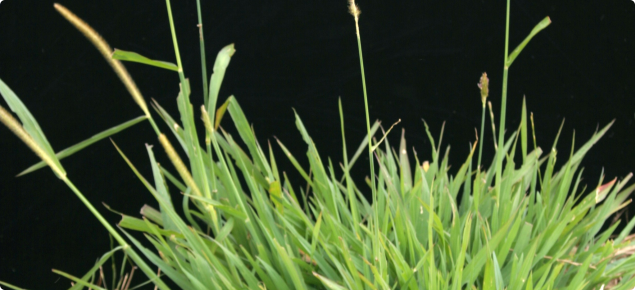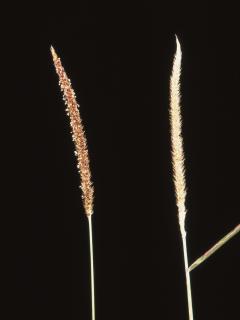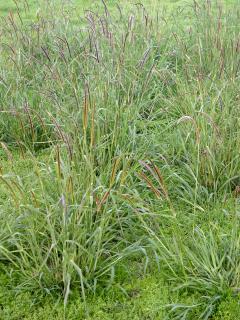Features
Setaria has the following features:
- a moderate to tall, bunch grass
- comparatively good cool season growth
- some varieties have good frost tolerance
- it contains moderate to high levels of oxalate.
The genus Setaria (Setaria sphacelata complex) includes a number of species that are used in agriculture. Setaria sphacelata var. sericea (setaria) is an out-crossing species that is widespread in its native Africa, but is mainly from regions where the rainfall is more than 750mm and without a pronounced dry period. In Queensland and northern New South Wales setaria is mainly grown in coastal districts.
Setaria splendida is suited to humid lowland tropics, but has to be planted vegetatively as the seed is sterile. However, the variety Splenda (PBR) is a seeding hybrid, which has shown some promise in WA.
Splenda and Narok setaria produced significantly more annual biomass and more biomass in summer and autumn than kikuyu in a field trial near Esperance on the south coast.
Purple pigeon grass (Setaria incrassata) is a bunch grass native to Zimbabwe where it grows on black cracking clays. In northern NSW and Queensland it is grown on fine-textured soils with Bambatsi panic and Rhodes grass. On these soils it is easy to establish and shows excellent seedling vigour. To date attempts to grow this species in south-western Australia have been unsuccessful. It appears to require high soil temperatures (~25°C) to germinate, which would preclude its use in WA.
The following refers to Setaria sphacelata var. sericea and the seeding hybrid Splenda (PBR).
Description
The morphology of Setaria can be described as:
- a robust, erect, densely tufted grass (0.9-1.8m)
- the base of vegetative tillers is flattened (fan-shaped)
- leaves are generally broad and mostly hairless
- seed head is ‘cigar’ shaped
Seasonal growth pattern
In WA, setaria grows actively in autumn after the rains. In areas with mild temperatures, winter growth is better than the other sub-tropical grasses, but in cold areas the plants are dormant over winter. Setaria resumes active growth in early spring and will grow opportunistically in summer depending on soil moisture. In northern NSW, setaria has a similar growth pattern to kikuyu.
| Rainfall (estimated minimum) | >550mm (>475mm south coast) |
|---|---|
| Drought tolerance | Moderate |
| Frost tolerance | Sensitive to moderate – Nandi and Kazungula are frost sensitive, while Narok and Solander will survive frosts of -2.0°C to -3.3°C, but heavier frosts will kill the leaves |
| Soil type | Adapted to a range of soils, especially those with a good water-holding capacity |
| Soil fertility requirements | Medium to high for good production. Highly responsive to N fertiliser and has a high P and K requirement. It will persist on low fertility soils |
| Soil pHCa | >5 (estimated) |
| Aluminium tolerance | Unknown |
| Waterlogging tolerance | Good |
| Salt tolerance | Nil |
| Ability to spread naturally | Low |
| Nutritive value: dry matter digestibility | 57–65% (monthly cuts), 47–53% (when cut after 72 days) |
| Nutritive value: crude protein | Average 9.8% (range 5.5–13.2%) |
Establishment
The suggested seeding rate is 1.5–2.5kg/ha of good quality seed when sown alone. Sow less than 15mm deep into a firm seed bed. Seedling growth is slow in the first year, but once established the plants grow vigorously. Plants are sensitive to moisture stress over the first summer and dry conditions can result in a high mortality.
Livestock disorders
Setaria contains moderate to high levels of oxalate, so is unsuitable for horses and can occasionally cause nephrosis or hypocalcaemia in ruminants. Pastures containing a high content of setaria (>95%) have resulted in cattle poisoning in Queensland.
The oxalate content depends on the variety, the growing conditions, stage of growth and increases with fertiliser nitrogen and potassium. The oxalate tends to be higher in the leaf blades than the stems while there is no oxalate present in the seed heads.
Management
In the first year defer grazing until the plants are well anchored. Test the plants to ensure they are strongly anchored before grazing.
When established, heavy grazing is required to maintain vegetative growth and palatability. Young leafy regrowth has good digestibility, but this decreases rapidly as the plant matures, so regular rotational grazing is required.
Setaria is often used for hay and silage in South Africa.
Companion species
Can be grown with other bunch grasses and Rhodes grass, but under good growing conditions is reported to suppress the growth of companion grasses. Should be compatible with a range of annual legumes.
Cultivars
There are four cultivars of S. sphacelatavar. sericea and one seeding hybrid. The early cultivars grown in Australia were Nandi and Kazungula.
Nandi (public variety) is from a highland region of Kenya and was selected for leafiness and vigour. It has less drought tolerance than Kazungula and is susceptible to frost damage. Nandi contains the lowest levels of oxalate (3.0–3.7%) among the commercial varieties.
Kazungula (public variety) is an ecotype from Zimbabwe that has good flood and drought tolerance and has slightly better frost tolerance than Nandi. It is a more robust and coarser grass than Nandi and flowers about one month later in spring. Kazungula contains high levels of oxalate (3.3–7.0%).
Narok (public variety) was bred for improved frost tolerance and will withstand frosts of -3°C with negligible leaf damage, although heavier frosts will kill the leaves. It has better cool season growth than Nandi and Kazungula and is also more leafy and palatable. It contains moderate levels of oxalate. Seed production is poor, as it has a low number of flowering tillers.
Solander (public variety) is similar to Narok in both appearance and agronomy, but has superior seed production. It was developed because of problems with low seed production in Narok.
Cultivar Splenda (PBR) is a seeding hybrid from a cross of S. sphacelata var. sericea and S. sphacelata var. splendida. It is a tall (>2m at flowering), robust, leafy grass which is later flowering than Nandi and Narok and has some frost tolerance. It has a high content of oxalate with the concentration in young leaf (4.7%) comparable to Kazungula. Splenda was developed for the humid tropics of north Queensland, but has shown some promise in field testing in the coastal districts of WA.



